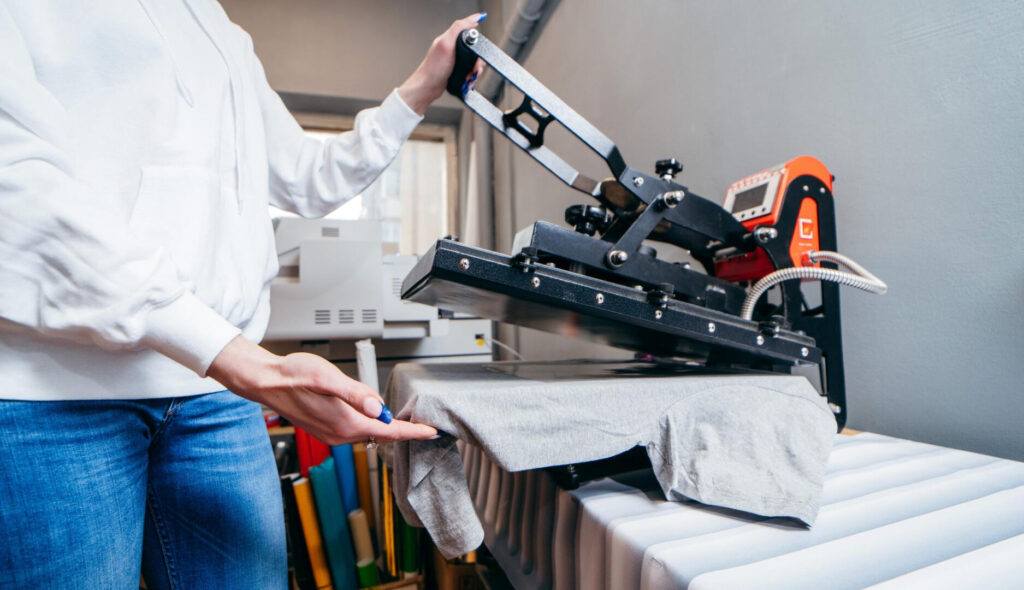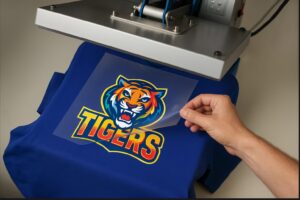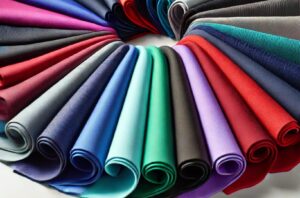The battleground for market share in the apparel industry is often won or lost in the fine details. The choice of printing techniques is one way that can significantly impact the quality, cost, and appeal of your products. Aside from sublimation printing, the topic between screen printing vs heat transfer continues to spark a debate.
This blog aims to distinguish these two methods. We’ll cover the pros and cons of each, their cost implications, associated production times, and suitable materials.
What is Heat Transfer Printing?
Heat press transfer printing is a method that has seen an increase in popularity over the last couple of decades. It involves the application of heat and pressure to imprint designs onto apparel. There are two primary types of heat transfer methods: vinyl and digital print, with both requiring a heat-press machine.
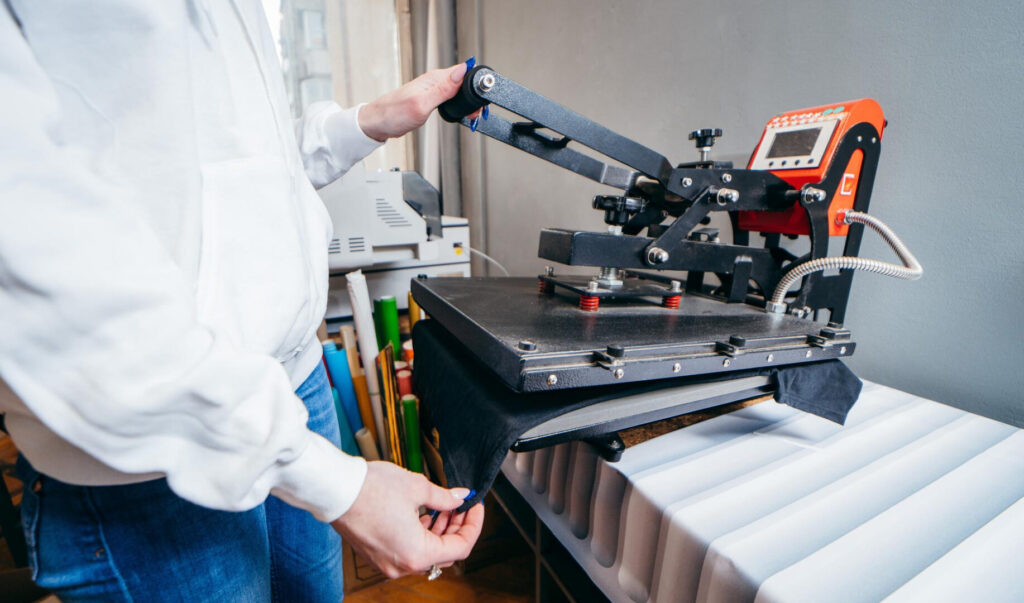
Vinyl Heat Transfer
Vinyl heat transfer involves a machine to cut out designs and letters from sheets of colored vinyl. These cut-out designs are then arranged on the apparel and a heat press is used to imprint the design onto the fabric. This method is ideal for producing apparel with simple designs such as team names, numbers, and multi-colored graphics.
You should consider heat-transfer vinyl printing when dealing with smaller orders, complex designs with multiple colors, or if you need to print on unusual locations or surfaces that can’t be easily screen printed.
Digital Print Heat Transfer
The digital print heat transfer process involves creating a graphic design on a computer which is then printed onto a special type of paper using solvent ink. This paper is then pressed onto the apparel using a heat press, which causes the ink to adhere to the material, effectively transferring the design onto the apparel. This method is perfect for more complex designs that involve multiple colors.
Pros and Cons of Heat Transfer Printing
| Pros | Cons |
| Cost-effective for smaller orders | Not ideal for darker colored apparel |
| Allows for complex, multi-colored designs | Designs don’t last as long compared to screen-printed apparel |
| Low setup cost | Can result in a stiffer feel on the fabric |
| Produces high-quality images | The colors aren’t as vibrant compared to screen-printed apparel |
| Easy to customize different apparel | |
| Environmentally friendly process |
What is Screen Printing?
Screen printing is a method that has been used for centuries, and involves creating screens to apply ink onto apparel. The process involves creating a stencil of the design on a screen, and then using a squeegee to apply ink through the stencil onto the apparel. This method is able to produce more durable and vibrant designs compared to heat transfer, making it an ideal choice for larger quantities of apparel.
Silkscreen vs Screen Printing
Silkscreen printing and screen printing may seem different, but they’re essentially the same technique, with roots tracing back to ancient China. Regardless of the term you prefer, this method involves applying ink to a screen and subsequently pressing it through a design or stencil on the screen.
Contemporary printers usually employ polyester screens as opposed to silk screens, yet the fundamental procedure aligns closely with its ancient Chinese origins.
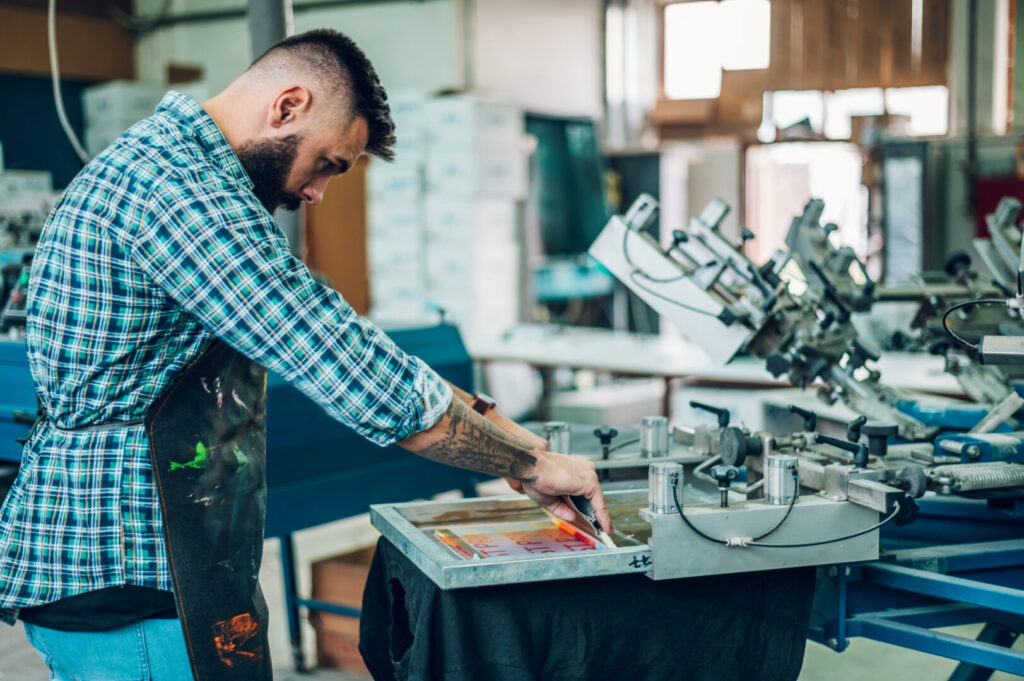
How Does Screen Printing Work?
Screen printing involves crafting a stencil, or a ‘screen,’ for each part of the design. The screens are kept in a frame, and ink is then pushed through the screen areas representing the design, directly applying it to the fabric.
When to Choose Screen Printing
Consider using screen printing for larger orders, when high durability is necessary, when printing on darker garments, or if a specific ink color or texture is needed. Choose screen printing when you seek vibrant colors and long-lasting prints.
Although heat transfer vinyl (HTV) offers substantial durability, it doesn’t quite match the lifespan of screen printing. Screen printing also facilitates multi-layer color schemes for more complex designs. It’s especially ideal for bulk orders or major projects, as the cost per item decreases with an increase in quantity.
Pros and Cons of Screen Printing
| Pros | Cons |
| More cost-effective for large quantities. | Limited to simpler designs with fewer colors |
| Yields a softer feel on fabrics. | Upfront setup can be messy and time-consuming |
| Designs are more durable and last longer | Expensive setup necessitates higher minimum orders |
| Enables more vibrant colors, even on dark-colored fabrics. | Not ideal for replicating photographs or complex images |
| Uses more chemicals and equipment than heat transfers |
Screen Printing Vs Heat Transfer Comparison
1. Initial and Ongoing Costs
If you’re looking to do smaller orders, heat press transfer is cost-effective. For larger orders, the per-unit cost of screen printing becomes more economical.
- Heat Transfer: Typically more expensive than screen-printed shirts. The price can go up based on design complexity and color count. Lower setup costs make it a good choice for smaller orders.
- Screen Printing: Initial setup costs are higher due to screens and quality inks. However, per-unit costs drop when you’re ordering in bulk.
2. Speed Vs Quality
The choice of printing method can also impact the time it takes to produce and deliver the apparel. For quick turnarounds, go with heat transfer. If you have time and want durability, choose screen printing.
- Heat Transfer: Faster process, making it an ideal choice if you’re under tight deadlines. However, it offers less durability.
- Screen Printing: This takes longer, especially for multiple colors, but results in more durable prints.
3. Material Suitability
For a wider variety of fabric colors, screen printing is more versatile. For light-colored fabrics, heat transfer often works best.
- Heat Transfer: Works best on light-colored fabrics where the colors pop.
- Screen Printing: Can deliver vibrant colors on a wider variety of fabrics, including darker ones.
4. Issues to Watch Out For
Heat transfer may require extra care in washing. If you’re prepared to manage ink and want long-lasting designs, screen printing wins.
- Heat Transfer: Prints may crack or fade over time, particularly with frequent washing.
- Screen Printing: Involves messy inks and requires careful handling.
5. Environmental Impact
If sustainability is a key concern, heat transfer might be your best option.
- Heat Press Transfer: Uses fewer chemicals, primarily water-based inks, leading to less environmental impact. Also produces less waste, as it doesn’t require screens, and is more energy and water-efficient.
- Screen Printing: Typically involves volatile organic compounds (VOCs) that can be harmful to the environment. Uses screens made of plastic and metal that can end up in landfills, and is generally less energy and water-efficient.
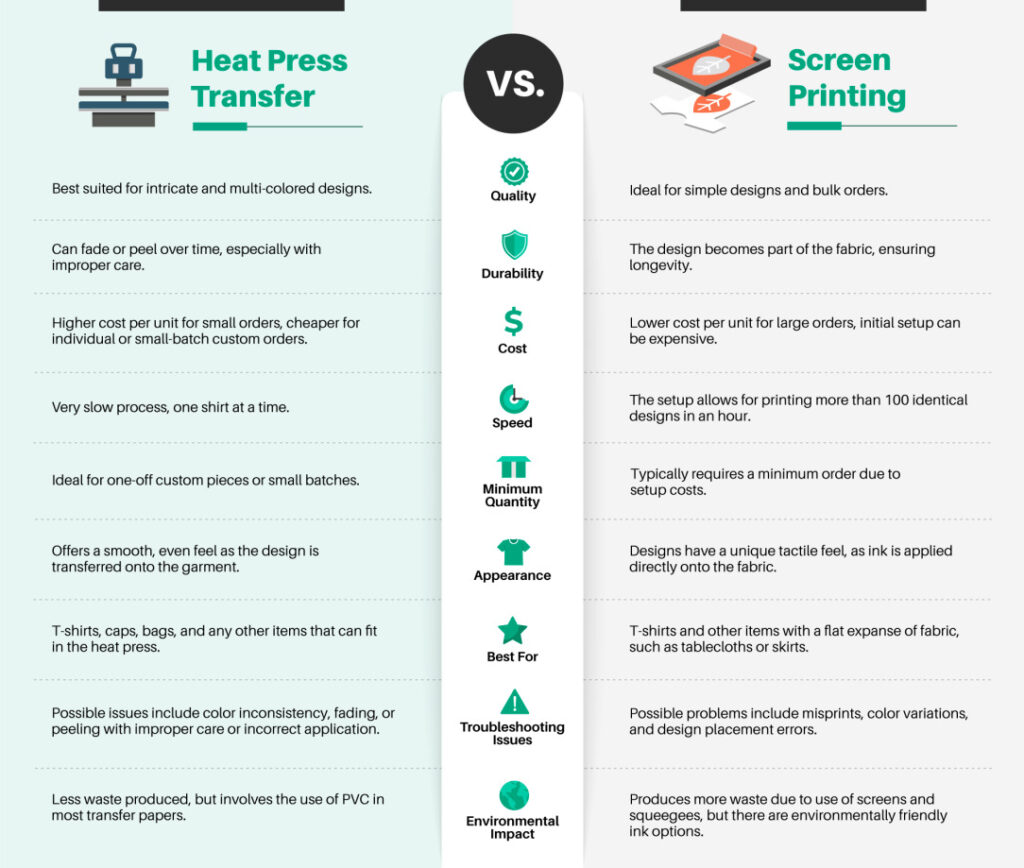
*Please note these are general guidelines. The specifics can vary based on the design, fabric, and other factors.
Which Method is the Best for You?
Picking between screen printing vs heat transfer is not a one-size-fits-all deal. It boils down to what you’re looking to achieve. Do you need intricate designs or are you working with specific fabrics? Maybe you’re up against tight deadlines. Each method has its strong points that could cater to these variables.
Therefore, the choice between heat transfer and screen printing is not about finding the “best” method, but about finding the right method for your unique needs.
Get Expert Guidance
In a growing industry where quality is key, choosing the right manufacturing partner can make all the difference. That’s why we offer a wide range of printing services, including heat transfer, screen printing, and sublimation printing.
Our team of experts has years of experience in the industry, and we understand the nuances of each printing method. We also focus on understanding your unique business challenges and needs, so we can guide you toward the most effective solutions.
Contact us for free expert advice and to get started manufacturing your apparel.

